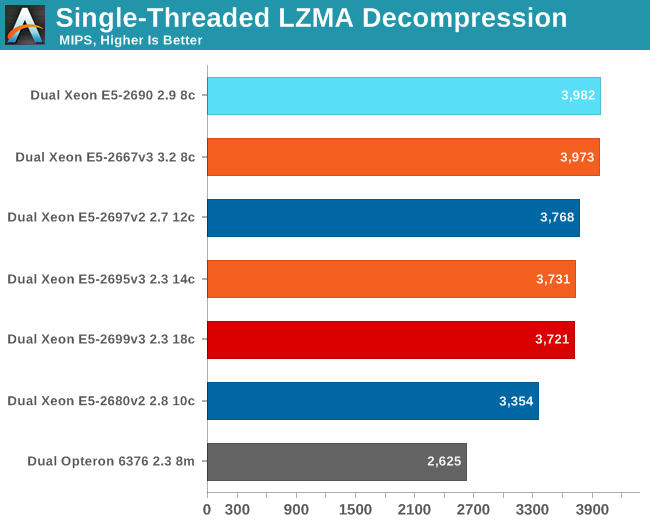Intel Xeon E5 Version 3: Up to 18 Haswell EP Cores
by Johan De Gelas on September 8, 2014 12:30 PM ESTSingle-Threaded Integer Performance
I admit, the following two benchmarks are almost irrelevant for anyone buying a Xeon E5 based machine. But still, we have to quench our curiosity: how much have the new cores been improved? There is a lot that can be said about the sophisticated "uncore" improvements (cache coherency policies, low latency rings, and so on) that allow this multi-core monster to scale, but at the end of the day, good performance starts with a good core. And since we have listed the many subtle core improvements, we could not resist the opportunity to see how each core compares.
The results aren't totally meaningless either, as the profile of a compression algorithm is somewhat similar to many server workloads: it can be hard to extract instruction level parallelism (ILP) and it's sensitive to memory parallelism and latency. The instruction mix is a bit different, but it's still somewhat similar to many server workloads. And as one more reason to test performance in this manner, the 7-zip source code is available under the GNU LGPL license. That allows us to recompile the source code on every machine with the -O2 optimization with gcc 4.8.1.

It looks more boring than it is. First of all, judging by the reactions on forums, many people expected that an 18-core E5-2699 v3 at 2.3GHz would be slower than a 3.2GHz Xeon E5-2667 v3. However you actually can have it all. The Xeon E5-2699 v3 and 2695 v3 boost their clock speed to no less than 3.6GHz when only one or two cores are active. The Xeon E5-2667 v3's maximum Turbo Boost is also the same 3.6GHz, so when only a few threads are active, the Xeon E5-2667 v3 has no clock advantage over the "mega/expensive SKUs" other than the fact that the clock speed will not drop lower than 3.2GHz if all cores are running at full bore.
Despite the fact that the Xeon E5-2690 core has lower IPC, it is able to keep up as it can boost the standard clock speed from 2.9 to 3.8GHz. As it is very hard to extract more IPC out of this kind of code, the extra 200MHz is enough to keep up.
Let's see how the chips compare in decompression. Decompression is an even lower IPC (Instructions Per Clock) workload, as it is very branch intensive and depends on the latencies of the multiply and shift instructions.

The older Xeon E5 takes the lead as decompression runs at very low IPC and is mostly depended on clock speed and low latency accesses. The new Xeon E5 v3 has slightly higher latency in both L3 cache and memory, so it falls behind.
What makes this benchmark interesting is that it proves that Turbo Boost works very well, even on an 18-core chip with a massive die. This is a big bonus, as especially in situations where you are setting up/preparing a system to be productive, it is very likely that you will be waiting for some single-threaded application to end. It also means that if one heavy request hits the server while it is running at very low load, the response time of the request will be low, keeping the impatient users happy.










85 Comments
View All Comments
cmikeh2 - Monday, September 8, 2014 - link
In the SKU comparison table you have the E5-2690V2 listed as a 12/24 part when it is in fact a 10/20 part. Just a tiny quibble. Overall a fantastic read.KAlmquist - Monday, September 8, 2014 - link
Also, the 2637 v2 is 4/8, not 6/12.isa - Monday, September 8, 2014 - link
Looking forward to a new supercomputer record using these behemoths.Bruce Allen - Monday, September 8, 2014 - link
Awesome article. I'd love to see Cinebench and other applications tests. We do a lot of rendering (currently with older dual Xeons) and would love to compare these new Xeons versus the new 5960X chips - software license costs per computer are so high that the 5960X setups will need much higher price/performance to be worth it. We actually use Cinema 4D in production so those scores are relevant. We use V-Ray, Mental Ray and Arnold for Maya too but in general those track with the Cinebench scores so they are a decent guide. Thank you!Ian Cutress - Monday, September 8, 2014 - link
I've got some E5 v3 Xeons in for a more workstation oriented review. Look out for that soon :)fastgeek - Monday, September 8, 2014 - link
From my notes a while back... two E5-2690 v3's (all cores + turbo enabled) under 2012 Server yielded 3,129 for multithreaded and 79 for single.While not Haswell, I can tell you that four E5-4657L V2's returned 4,722 / 94 respectively.
Hope that helps somewhat. :-)
fastgeek - Monday, September 8, 2014 - link
I don't see a way to edit my previous comment; but those scores were from Cinebench R15wireframed - Saturday, September 20, 2014 - link
You pay for licenses for render Nodes? Switch to 3DS, and you get 9999 nodes for free (unless they changed the licensing since I last checked). :)Lone Ranger - Monday, September 8, 2014 - link
You make mention that the large core count chips are pretty good about raising their clock rate when only a few cores are active. Under Linux, what is the best way to see actual turbo frequencies? cpuinfo doesn't show live/actual clock rate.JohanAnandtech - Monday, September 8, 2014 - link
The best way to do this is using Intel's PCM. However, this does not work right now (only on Sandy and Ivy, not Haswel) . I deduced it from the fact that performance was almost identical and previous profiling of some of our benchmarks.